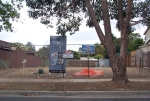These preliminary notes have been prompted by a series of photographs taken around South Blackburn in the municipality of Whitehorse. The photos clearly reveal many examples of moonscaping, a practice in which housing blocks intended for residential development are savagely razed and denuded of any vegetation following demolition of existing structures.
Drive or walk anywhere through Whitehorse and you will see block after block waiting to be developed, or in various stages of development. Common to these sites is that they are treeless with every remnant vegetation ripped out to facilitate bigger or higher density development on the land. Moonscaping is the most appropriate name for this. Significant examples of site moonscaping , i.e., total clearing of sites as a precursor to development rather than an attempt to incorporate existing vegetation has a devastating impact on native species of most residential and commercial buildings. It is common for developers to remove most of the vegetation and even topsoil (Sharpe et al. 1986). (Urban Ecology, 9: 267-287). This reduces construction costs by allowing equipment ready access to the construction site.1
McKinney argues that the loss of native vegetation has a negative impact on native animal diversity, including a dramatic decline in richness of bird species. Following construction, areas of paving plus replanting with non-native species further reduce habitat. Such construction renders it impossible to retain the distinctive vegetation character and compromises the available space for replacement vegetation. One way to preserve remnants in housing developments is to retain predevelopment vegetation. Refer to The Landscaping Revolution (Wasowski and Wasowski 2000).
Because landscape alteration typically results in modification of native vegetation cover leading in turn to a loss of habitat for many species, it is incumbent on Council planners to design, regulate and enforce sustainable urban development guidelines. The retention of small vegetation patches can make an important contribution to biological conservation in human-modified landscapes. (Saunders ,D.A & Hobbs, R.J., 1991).
Wildlife corridors, i.e., physical linkages between patches of native vegetation contribute to landscape connectivity and may facilitate habitat connectivity for some species. ( Bennett : 1998). Such corridors facilitate the movement of animals and birds through sub-optimal habitat. Wildlife corridors provide habitat for resident populations and prevent and reverse local extinctions by recolonization of empty patches. ( Bennett: 1998).
Streetscape vegetation plays an important role in influencing bird communities. One study has reported on the prevalence of native plants leading to high native species richness whereas exotic and newly developed plants lead to more introduced and fewer native species. ( The Victorian Naturalist:2009).
In conclusion, it is argued that habitat fragmentation and landscape change wrought by moonscaping poses a dramatic threat to the leafy environs of Whitehorse and that a concerted planning regimen is urgently required to arrest further loss.
1 Urbanization, biodiversity, and conservation
Mc Kinney, Michael L
Bioscience; Oct 2002; 52, 10; ProQuest
Pg.883
Bibliography
The Victorian Naturalist 126.3 (2009): 73.
Bennett, A.F. Linkages in the Landscape:The Role of Connectivity in Wildlife Conservation. 1998.
Lindenmayer, David B, & Fischer, Joern. Habitat Fragmentation and Landscape Change. CSIRO, 2006.
Mc Kinney, Michael. “Urbanization, biodiversity, and conservation.” Bioscience 52.10 (2002): 883-890.
Saunders, D.A. & Hobbs, R.J., ed. Nature Conservation : The Role of Corridors. 1991.
Sharpe. Urban Ecology 9 (1986): 267-287.
Wasowski, Wasowski &. The Landscaping Revolution. 2000.
Anne C. Tan
April, 2014
Photos of Six ‘Moonscaped’ Sites in Blackburn South: April 2014
Photographs: David Berry






